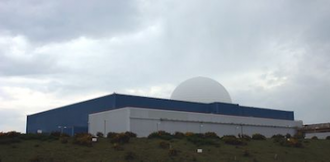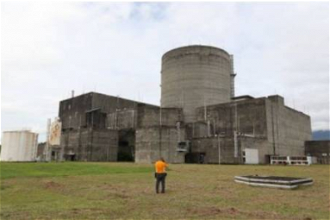Ian Linden: Sizewell C - too destructive, too expensive, too late

Sizewell B - Wiki image by John Brodrick, greenhousetrust
Joan Girling grew up near the Suffolk coast with its little terns, barn owls, harebells, ladies bedstraw, sedums, blue butterflies and acid grassland. There was no nuclear power station. "It was perfect, a nature lover's paradise", she told me.
In 1959, Joan's father, faced with compulsory purchase, was forced to sell off a corner of their front garden with its large pond full of water lilies and wildlife. It was to make way for workers' traffic to the site of Sizewell A, a nuclear power station, today a great, ugly, Stalinist-looking excrescence looming above the sea-shore. Her grandmother who lived next door watched as they filled in the pond. "The worst part was to hear my grandma crying. I remember it as if it was yesterday".
In the late 1980s it all happened again: Sizewell B. This time Joan moved house with her family to escape construction traffic. From 1993-2005 she served on Suffolk County Council. Fifteen years ago, Joan Girling became a founding and deeply dedicated member of Community against Nuclear Expansion later renamed Together Against Sizewell C (TASC).
The human and environmental costs ought not be underestimated. The disruption and destruction accompanying years of building accounts for the level and persistence of local protest. Stop Sizewell C, originally a parish of Theberton and Eastbridge action group, alongside the local Friends of the Earth, joined TASC in a long-running legal campaign. Crowd financing helped fund three rounds of court action seeking judicial review of the Sizewell C project. The last challenged the Business Secretary, Kwasi Kwarteng's, 2022 Development Consent Order giving the green light to start construction. Kwateng rejected the Planning Inspectorate's conclusion (part of the process required by the 2008 Planning Act) that in the absence of an assessed, permanent, potable water supply for the project, "the case for the grant of development consent is not yet made". Sizewell C will be forced to use a desalination plant during construction. The Court of Appeal found for the government in December 2023.
The construction of Sizewell C means heavy truck traffic. New roads, a large park and ride facility, as well as a railway branch line, will have a major impact over a large area much of it designated by Natural England - sponsored incidentally by the Department of Environment, Food and Rural Affairs (DEFRA) - as a Suffolk Coast and Heaths National Landscape (formerly Area of Outstanding Natural Beauty). A small bite comes out of reed beds and marsh land declared a Site of Special Scientific Interest. The new reactors will lie right next to Minsmere, a popular RSPB reserve where the drain-pipe boom of the bittern can be heard. Building Sizewell B will blight tourism for two decades but boost other aspects of the local economy. But before dismissing protest as Nimby-ism (Not in My Back Yard) it is as well to evaluate what lies in the backyard.
Sizewell C planning first saw the light of day under Prime Minister Gordon Brown, 2007-2010, when coastal Suffolk was selected alongside other sites with existing nuclear reactors The initial choice of investors, EDF (Electricité de France) and a Chinese Company CGN, was almost as contentious as the choice of site. In 2009 EDF, 85% French government owned, bought British Energy, the UK's largest electricity energy-generating company. By 2019 EDF was over 50 billion Euros in debt and its share price had dropped from 42 to 10 Euros. The company was re-nationalised in 2023. EDF's track-record building two reactors at Hinkley Point, Somerset, does not inspire confidence that all manner of things will be well at Sizewell C. Building of the EDF's first Hinkley Point reactor began in March 2017 but is unlikely to be completed before 2030 at a cost of possibly £47 billion (the initial estimate in 2016 was £18 billion).
Actual construction of a reactor starts usually after three years of preparatory work once a Final Investment Decision (FID) is issued indicating that financing for the entire project looks assured. FID for Sizewell C remains 'expected' by the end of this year. Professor Stephen Thomas of Greenwich University Business School estimates the length of time from inception to first commercial power production of nuclear power stations worldwide at between 15-20 years. Given the pace of climate change, that is too long to wait.
Geopolitics put paid to Chinese part ownership in Sizewell C; CGN's stake was bought out by the UK government in 2022. Nuclear power is costly. Government, now the majority shareholder in the project, turned to what is called the Regulated Asset-based (RAB) model, an array of investors, in a bid to attract pension funds. But this has not been successful. It is now wooing investors such as the United Arab Emirates (UAE) and the UK electricity company Centrica. Professor Thomas' optimistic estimate of cost for 13 years of Sizewell C construction is £26.3 billion and his pessimistic, some would say realistic, estimate for 17 years, £43.8 billion. Just too costly.
No-one knows what international energy prices will be when the reactors start up - thus creating a very wide margin of risk. RAB offers possibilities for the government to reward potential investors. In Thomas' words: "First, because the risks will fall on consumers and taxpayers, the project would be seen by financiers as low risk to them and would attract a low interest rate. Second, the finance charges [and these would be significant] would effectively be paid by consumers as a surcharge on their bills payable from the date of FID to completion of the plant".
There are alternative sources of energy. In the past fifty years, the cost of renewables has gone down, real nuclear costs have only ever gone up. But Shell expects to make 15% profit on investment in oil and gas against 5-8% returns from renewables. This is one reason for the continuing investment in new fossil fuel extraction and faltering financing of the realistic option for meeting carbon emission reduction targets; solar panels and wind turbines. Government colludes with energy companies and investors seeking to be as risk-free as possible, with their decisions and actions critical for mitigating climate change, based on profit taking at the expense of the citizen/consumer.
To read on see: www.ianlinden.com/latest-blogs/sizewell-c-too-destructive-too-expensive-too-late
Professor Ian Linden is Visiting Professor at St Mary's University, Strawberry Hill, London. A past director of the Catholic Institute for International Relations, he was awarded a CMG for his work for human rights in 2000. He has also been an adviser on Europe and Justice and Peace issues to the Department of International Affairs of the Catholic Bishops Conference of England and Wales. Ian chairs a new charity for After-school schooling in Beirut for Syrian refugees and Lebanese kids in danger of dropping out partnering with CARITAS Lebanon and work on board of Las Casas Institute in Oxford with Richard Finn OP. His latest book was Global Catholicism published by Hurst in 2009.


















